Welcome to another thrill packed newsletter, which I hope you will enjoy, and also do search out some of our website links. Last week we had lots of response to our questions, and we even managed to track down a proper card of the Lambert and Butler “Colonel R.S.S. Baden-Powell The King of Scouts” - many thanks to Brian Billington. If you want to see that, as I am sure you will, nip over to last week`s edition. These newsletters are now permanent, and now the mornings are getting lighter earlier I hope to have a good go at indexing them and turning the pictures in to a proper searchable gallery. Once that is done it will be uploaded for you to use.
So on to this week, when we feature banknotes, bears, and bravery [that of the sword swallower] – and that`s just the first three days…..
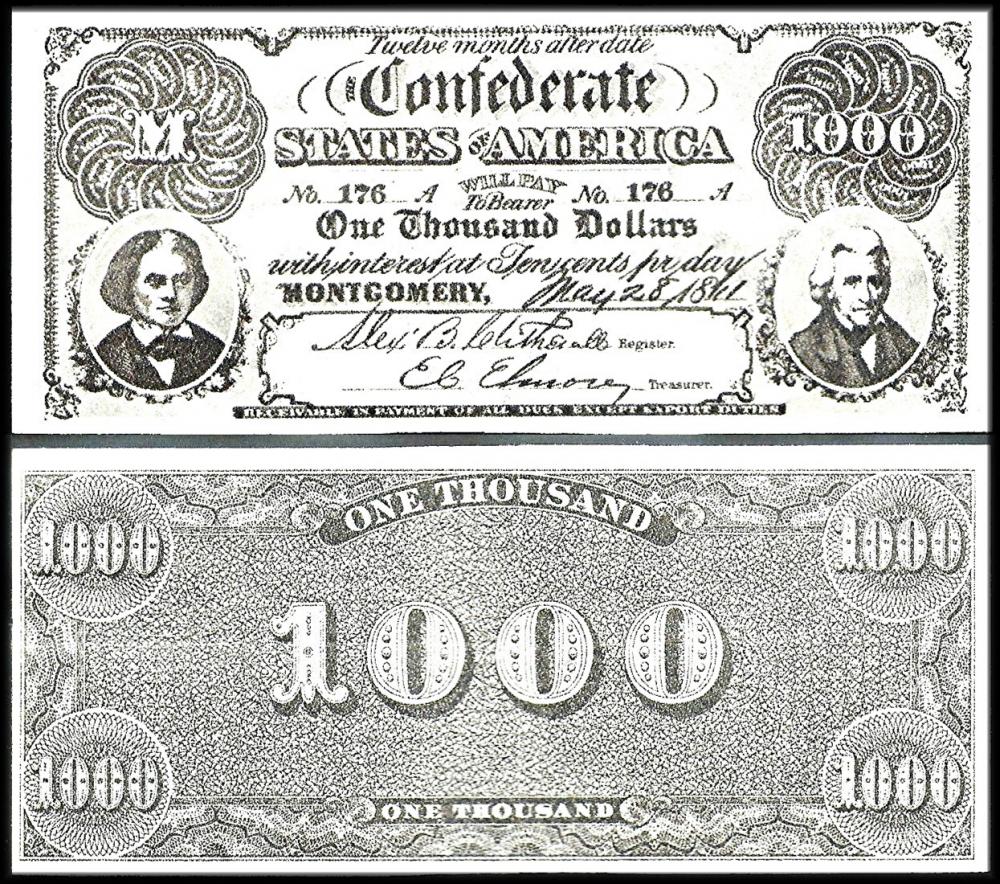
A & B.C. Gum [trade : bubble gum : UK] "Civil War Banknotes" (1965) Un/17 –AAB-140 : ZG9-1
Today in 1797 the Bank of England issued its first £1 note.
Though coins often appear on cigarette and trade cards, banknotes are rarer. The main reason for this is probably that the coin was more recognisable in a two dimensional form, and that the banknote is less photogenic. Oddly, whilst the first ever banknote was used in China in the seventh century, the first fully printed banknote in the UK was not issued until 1853, all of the earlier ones being hand written to suit the location and amount required.
Our card is not really a card at all, because in 1965 A & B.C. Gum issued a set of 88 cards called "Civil War News", and they are discussed as part of our newsletter for the 15th of February, 2025, just scroll down to Monday the 17th of February. But along with those cards, in the same packet, came these reproductions of banknotes, from that conflict. However A. & B.C. Gum did not think to add their name, so no issuer appears on these notes, nor a title, and so they ended up being listed as a "Z" code, in the back of our vintage British Trade Index part II, though, oddly this text does mention their issuer, and reads :
Civil War Banknotes (A) Lg. 142 x 62, on stiff paper. Buff and grey-black, reverse in grey-black. Unnd. (15). Issued by A & B.C., with set ABF-4. ... ZG9-1
A list of the notes issued appears that text, which we have scanned - it reads :

You will see that it starts with a dollar bill, but goes up to five hundred and even a thousand dollar note which we picked for our main illustration. However the ordinary soldier would almost certainly have never been aware of these.
This listing is updated in our original British Trade Index part III, where it appears as part of the A. & B.C. Listing, as :
Civil War Banknotes. (15). Issued 1965 with set ABF-4 and set ZG10-9.1. |See Anonymous set ZG9-1 in II
Now that ZG10-9.1 is not a typo, it can actually be found in the back of the book of this original British Trade Index part III, and it is listed along with the A. & B.C. set of "The High Chaparral", which was issued in 1969. I have to say I thought this a rather tenuous link, but, of course, Big John had been on the Union side, whereas the head cowhand, who was also his brother, had been a Confederate, and sometimes passing ex soldiers awakened old memories and past grievances, at least enough to base an episode on when they could think of nothing else.. However looking at the listing which follows in British Trade Index III, it is plain to see that these are entirely different bank notes, and nothing to do with the Civil War - in fact, they are the ones which were issued with A. & B.C. Gum`s "Flags of the World" - cut outs - in 1971. This seems very odd, and nothing at all to do with the High Chaparral. So was the wrong list printed in here? Maybe a specialist would like to let us know....
By the time of our updated British Trade Index these banknotes were added to the main body of the text and listed under A. & B.C. Gum. The description is slightly different, reading : it gives the date of 1965, and it says “Design backs” without stating a colour. It also adds a code of HA-4, which is the handbook, where the notes are now listed.
Some time after this there was discovered to be seventeen notes, not fifteen. To see all the notes nip over to Bob Heffner`s Civil War News and follow the link to the banknotes. And if you are able to find the three that are the new ones before I do please let us know
This set actually has an entry all its own at Wikipedia/CivilWarNews - and it actually shows a packet, though this is an American packet, for it says it costs 5 cents. You can see a British packet online at Vintage Non Sports.com/CWN. In both of these cases do "note" that this is not a packet for the money, it is a "Civil War News" card packet. However seeing these two does pose an interesting question, for the British one says "Civil War Picture Card Bubble Gum Plus free Confederate Dollars", all of which was printed at the same time, whilst the American one has the words "Confederate Money" in ornate red text, which I think is the playbill font, with the word "Extra" above in black, but rather squeezed in between the black and the red is the word "Facsimile". So was there a complaint from someone who thought the packets contained real money, and this overprint was the way around it? And does anyone have a packet without those words on?
Anyway this all proves that the notes were included in the packets with the cards, but there was a problem, that being the size of the notes - for they were too large to fit in the packets. This must have been noticed after they were printed and caused much head scratching. Then they came up with a plan, which was simply to fold the notes in half and put them in. Unfortunately that means all the issued notes are creased, and it is not even counted as damage by many collectors, so do be very careful to examine the pictures before you bid on or buy any of these.
By the way all the notes used are indeed from the Confederate side, and they were originally issued from 1861 to 1865; there are approximately a hundred different types of the original banknotes, if you count the non-regular and local issues, and this does not include all the notes which were regularly counterfeited by the Union forces.
Roberts World Money is a website devoted to all kinds of coins and notes and it has a page showing a fascinating selection of early trade cards which feature banknotes. These are very scarce and highly collectable.
One of the few sets of cigarette cards devoted to banknotes is catalogued in our World Tobacco Issues Index as R785-570. It was issued by Rothmans in 1970, hence they do not appear in the 1956 original version. Despite this our updated Index catalogues them in a section for “Issues in the 1950s and 1960s”. The set is called either “Rare and Historic Banknotes” or “Rare Banknotes Collection”, and is just five large sized cards. The notes included are 1. German 20,000 marks hyper-inflation note of 1923 – 2. Bulgarian 25 leva note from 1951 – 3. Greek ten million drachma note of 1944, another inflation piece – 4. Chinese Bank of Communication 10 yuan note from 1941 – 5. A Yugoslavian 1 dinar note, a liberation issue of Marshal Tito, from 1943. There was also a blue folder to keep them in, which opened to 142 x 36 m/m., but to get that you had to send the set in exchange and a 4d stamp (those were the days!). Now I am not sure if they sent the cards back and you put them in the wallet or whether the wallet contained actual bank notes. Maybe there is someone out there who will let me know.
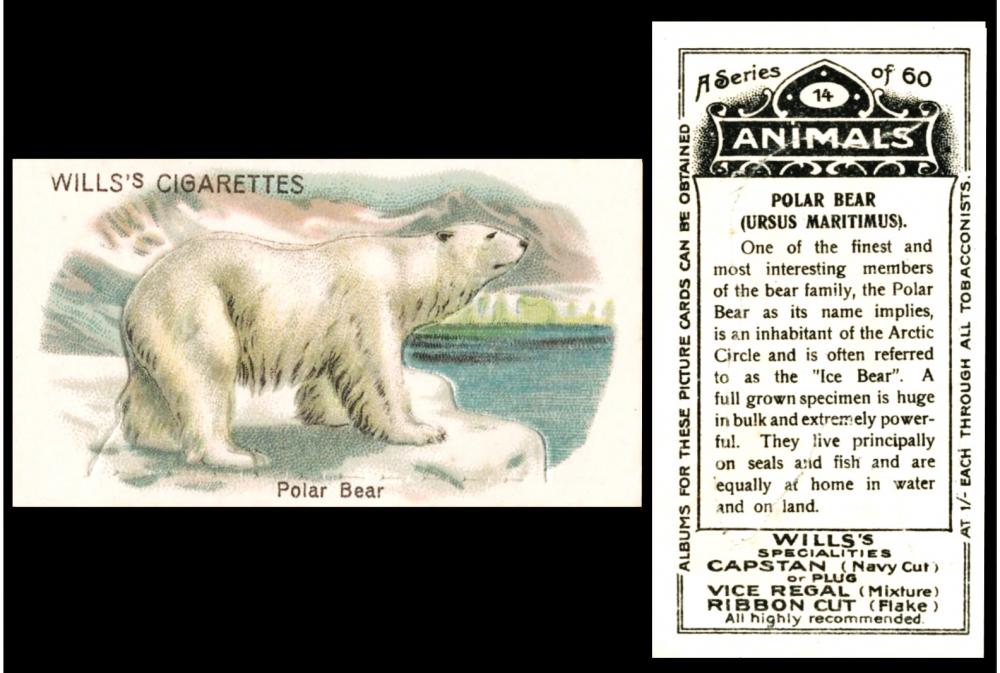
W.D. & H.O. Wills [tobacco : UK] "Animals" cut outs (1910-1915) 14/60 - W675-334 : W62-212 : W/137 : RB.21/200-37 : RB.15-17
Today is international polar bear day.
John Player “Wild Animals Heads” (P644-290 : P72-141 : P/196 - June 1931) 5/50 tells us that the Latin name of this beautiful bear is Thalarctos Maritimus; you may think this is wrong, and it ought to be Ursus Maritimus, but actually both are right, and both mean “maritime bear”. Most of these bears live within the Arctic circle, and they are approximately the same size as a Kodiak Bear, so share with it the title of the world’s largest bear and largest land carnivore, 680 kg being a typical maximum weight for a male. Sadly they are now in danger, through hunting and through climate change which affects the ice they live on, the food they eat, and the temperature. They can stop eating at will, living off stored fat, but there is a limit to even their endurance.
You will often find them advertising soap, or other substances where whiteness is seen as a virtue. And they also appear on packets of “Polar Chewing & Smoking Tobacco” by Luhrman & Wilbern, successors to P. Lorillard. Cartophilists might think the most exciting thing about this is that this packaging once contained those A565-034 : T206 “Baseball Series” cards! Sadly for us the bear does not appear on the reverse of those cards, just lineage, but he was used on other paper material by the company, including a lovely example which you can see at the antique advertising website
Cope Bros. & Co, Ltd of Liverpool and London adds to the tale with “Wild Animals and Birds” (C798-290 : C132-35 - 1907, of which there is an English and a Scandinavian version) 4/25, by telling us that they are “very versatile and naturally adapted for withstanding extremes of hot and cold climates…It is a dangerous foe and uncertain in temper – sometimes running away at the mere sight or scent of man – at other times fiercely attacking him. And a particularly ferocious one appears as one of the Allen & Ginter "Wild Animals of the World" (A400-250 : A36-25 : USA/25 - 1888). Another early card is Mackenzie & Co. of Glasgow, whose black and white set of “The Zoo” (M093-800 : M16-3 - 1910) starts with a polar bear as card 1/50.
Sadly the later you get the more likely it is that the bears will be in zoos, including B Morris & Sons of London, with “Animals at the Zoo” (M884-310 : M142-21 –1924) 12/50, and “Whipsnade Zoo” (M884-490 : M142-36 - 1932). In the 1930s the best known polar bears were Sam and Barbara at Whipsnade Zoo, who feature on several cards in Major Drapkin & Co`s “Life at Whipsnade Zoo” (D800-575 : D64-29 - December 1934) a set of 54 cards These are all attractive cards but I am not fond of the zoo environment, and though the cards show they tried their best to entertain them during the long boring days, the fact remained that they were trapped, not roaming free.
Our card is slightly different, and comes from a most attractive set issued in Australia "between 1910 and 1915" - though popular opinion has it pegged to 1913. The card is not just a card though, for if you look along the outline of the bear you will spot the little perforations, and this allows you to push the background away and let him stand up in a three dimensional manner.
The original write up on this set is in our original Reference Book part three to the issues of W.D. & H.O. Wills, where it says it is :
37. 60 ANIMALS (cut outs). Size 66 x 35 m/m. Fronts lithographed in colour; backs in black with descriptive text. Australian issue between 1910 - 15.
A) with "Havelock" advertisement at back
B) with "Wills Specialities" advertisement at backSimilar series issued by B.A.T. and Ogden; there is also an anonymous plain backed issue which is being recorded in the Ogden booklet.
The full list of those other tobacco issuers, extracted from RB.21, the British American Tobacco Reference Book, is :
A. Wills` "Havelock" export brand issue
B. Wills` "Specialities, Capstan, Vice Regal and Ribbon Cuts" export brand issue (this card)
C. Ogden`s "Ruler" export brand issue
D.i. Ogden`s "Tabs" export brand issue - with caption
D.ii. Ogden`s "Tabs" export brand issue - without caption
E.i. Ogden`s unbranded plain back Issue - with caption
E.ii. Ogden`s unbranded plain back issue - without caption
F.i.a. Millbank issue, numbered 1516 at bottom of front - "Printed in England" in red
F.i.b. Millbank issue, numbered 1516 at bottom of front - "Printed in England" in bluey-grey
F.i.c. Millbank issue, numbered 1516 at bottom of front - "Printed in England" in black
F.ii. Millbank issue, numbered 3971 at bottom of front
G. Kong Beng brand issue
It also tells us that printings A. B., and F. are numbered with series title and descriptive text. However printings C,., D., E., and G. are unnumbered, without series title or descriptive text.
As we feature these cards we will bold the text, and add a link, the clicking on which will let you go off and see them. So far only one has been done though!
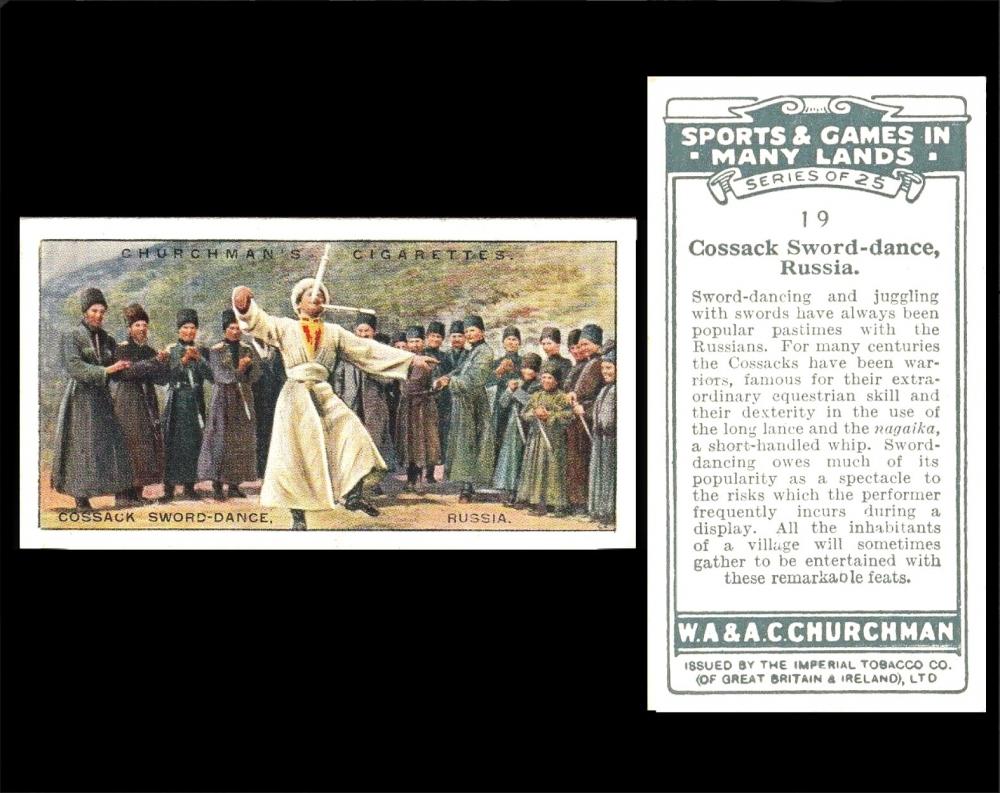
W.A. & A.C. Churchman [tobacco : UK] “Sports and Games of Many Lands” ( August 1929) 19/25 - C504-660 : C82-81 ; C/133
Today is International Sword Swallowers Day.
Cards of swords fall into two categories; most are in the regalia class, used for royal or legal events, and you will find those in sets such as Churchman “Civic Insignia and Plate” (C504-445 : C82-39 –May 1926), or in the many Coronation series that were issued as we changed Kings and finally Queen.
Swords as edged weapons do appear, several can be found as part of the pictures of Smith`s “Battlefields of Great Britain” (S548-050 : S84-2 - December 1913). And John Player “Arms and Armour” (P644-040 : P72-15 - April 1909) has a sword combat as card 24/50 showing two mounted knights, in a good illustration of how jousting became such a useful sport in the pursuit of war, plus a card of a pair of foot soldiers with swords, which tells us that the small shield shown was known as a “buckler”, and that it was “the clashing of these two weapons earned for the swordsmen of that day the nickname of “Swashbuckler”. The same set was also issued by Hignett (H536-200 : H44-31 – December 1924), Mitchell (M757-220 : M122-11 - July 1916), and W.D. & H.O. Wills (W675-336 : W62-213 : W/38 - 1910) in Australia with various brandings, Capstan Navy Cut in two versions (“pipe” and “plug”), Havelock, and Vice Regal, as well as anonymously, and with United Service.
However, with moments to spare, I have actually found a sword swallower, or as near as makes no difference! That shows a Cossack Sword Dance and the Cossack has two swords in his mouth, or, more correctly, a sword and a dagger. The set was also issued by Edwards, Ringer & Bigg (E265-860 : E14-44 – 1935), and anonymously, overseas by British American Tobacco.
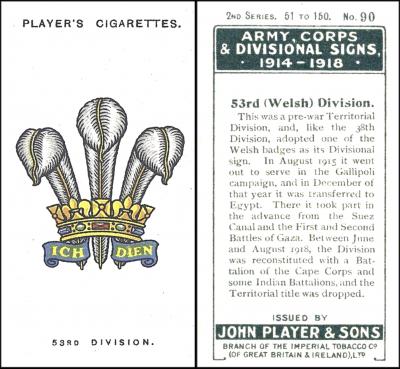
John Player & Sons [tobacco : UK] "Army, Corps & Divisional Signs" 2nd Series (1925) card 90
Today it is St. David's Day, so special greetings to our readers who are Welsh by birth or by circumstance, or those who collect Welsh cards.
We have a little quest for you this week, that being to see if you know, or can track down, any information about two cigarette card clubs in Wales. Yes really!
The first one was South Glamorgan Cartophilic Society, it was actually a non-affiliated branch of the Cartophilic Society, and the first mention I have found of it is when it springs up on the inside back cover of Cartophilic Notes and News Vol.11, No.121, September/October 1983. The meeting date given was Friday 7 October 1983 at the police Social Club, Queen Street, Cardiff. The secretary was Mike Hurn of Cardiff. I have not found any mention of them before that. There are no meeting dates in the following issue, but they are there in the ones after which covers March/April to September/October 1984, albeit without any meeting date, just “Contact Secretary for details”. In the November/December 1984 issue, it is just the name and address with no mention of meetings at all, and so it stays up to and including Vol.16, No.154, March/April 1989.
Sadly, I have a gap in my magazine library at that junction, and my next copy is January/February 1996 (Vol.21, No.195). In this there is not a sign of South Glamorgan Cartophilic Society, but there is details of South Wales Cigarette Card Club, who were also non-affiliated. Their secretary was Grahame Jones of Bridgend, Mid Glamorgan. However then there is a gap in the publishing of branch details, which is rather awkward for anyone trying to follow the story of any of them. They were listed in November/December 1996 (Vol.21 No.200), but then I know no more because only main and affiliated branches and clubs were listed, not the non-affiliated.
So were you a visitor to either or both of these, or can you help us out by supplying any other information? If so, let us know!

W.D. & H.O. Wills - Embassy brand [tobacco : UK] “World of Speed” medium size (1981) 8/36 - W675-296
Today in 1969 Concorde, the Anglo-French supersonic airline, shot into the skies on its maiden flight at twice the speed of sound. Of course, this is not true for it took some time to achieve that speed.You might think that you will never find Concorde on a cigarette card, but you will – not just our card, which has an artists impression, and tells us she could carry up to 128 passengers at speeds in excess of 1450 m.p.h.”. Other artist`s impressions are on W.D. & H.O. Wills Embassy branded “World of Speed” medium size (W675-296 - 1981) set of 36 cards, and W.D. & H.O. Wills Castella “British Aviation” extra large (W675-259 - 1994) set of 30 cards
Six of these Castella cards, including Concorde, were selected to be reprinted as beermats, as had happened with their “Donington Collection” cards (W675-262) the year before.
And lastly but not leastly there is also an actual photograph of her on John Player Tom Thumb “Wonders of The Modern World” large size (P644-460 - 1985) 8/30, where she is described as “the world`s first successful supersonic airliner.” is also an artists impression.ore.
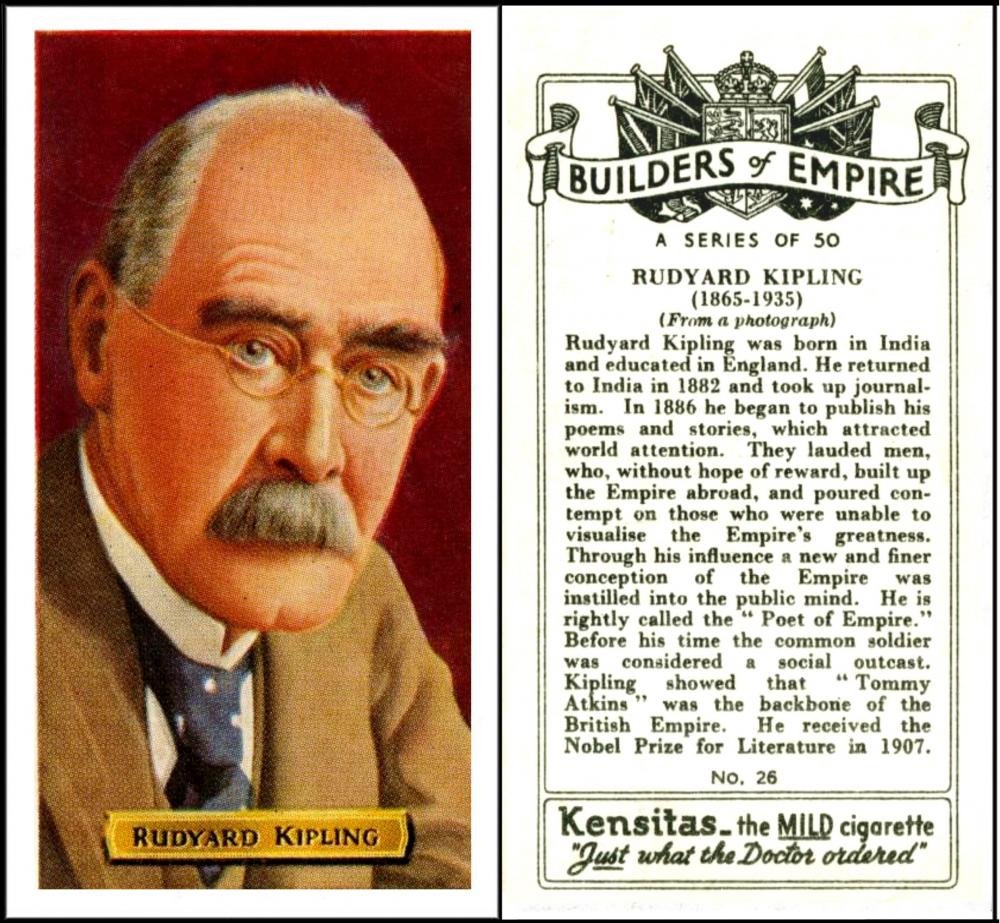
J. Wix - Kensitas Brand [tobacco : UK] "Builders of Empire" (1937) 26/50 -
Today there are two important events – World Wildlife Day and World Book Day
World Wildlife Day is now regarded as the main event of the year to do with wildlife and its survival. The date actually commemorates the signing, in 1973, of the CITES document, or Convention on International Trade in Endangered Species of Wild Fauna and Flora. It did not become World Wildlife Day until 2013, when the United Nations made it so, and as this was in December of that year, the first World Wildlife Day did not take place until 2014. It seems quite amazing that is less than ten years ago. This year`s theme is "Recovering Key Species for Eco-system Restoration".The official website has details of many events, some of which are online. Do try to tune in.
World Book Day, which is celebrating its 25th Anniversary this year. Whilst mainly a children`s event, reading is extremely valuable, and it need not cost anything. Every area has at least one library, and also there are Little Local Book Hubs springing up all across the country. If you cant manage those there are lots of free books to read online. In fact most libraries also have online books and magazines.
In order to combine the two why not select a book on the natural world. BooksVooks seems rather relevant, and I am sure you will find something there to read. If you cant think of anything, Rudyard Kipling`s "Jungle Book" written in 1894, is sure to give you much food for thought.
![O100-432 : O/105 [tobacco : UK] Ogden`s “Infantry Training” (1915) 25/50](/sites/default/files/styles/content_aligned/public/2022-02/26%20march.jpg?itok=ICWsA_qv)
Ogden`s Ltd [Tobacco : UK] "Infantry Training" (1910) 25/50
This is not an actual public holiday but I like the sound of a movement to make it “March Forth and Do Something Day”. We have all been guilty of not using our lockdowns as productively as we might have, and as we slowly start our new lives it is the perfect time when we should all start looking for what we want to do with the rest of them, and more importantly take steps towards doing just that. They might be but dreams now, but sometimes dreams are little nudges to what you really want, and you can at least look into them and find out how they might be attained.
None of us know how long we will have left, especially at the moment, so let us all “March Forth”.
I had no idea of how I might find cards for this! But in the end I came up with Ogden`s “Infantry Training” (O100-432 : O/105 - 1915) 25/50 – a similar set to which was issued overseas by Imperial Tobacco Co of Canada. This card shows “On the March, Eyes Right”. You may be wondering why the military, and boy scouts, place such regard in marching? Well there are several answers, but mostly that it stops the brain wandering away, because the rank has to stay in step and you have to think about that, whilst also thinking of the additional instructions, like “Eyes Right”. It also looks impressive to rival forces, but more than that it is very hard to tell how many men there are if they are all in unison, and when asked to guess the size of things most people seem to opt for larger numbers rather than smaller ones. Have a look at this yourself some time when you see a march going on. And finally, very relevant to our day, think of the time it takes to teach all those bodies to march together, time that is then not wasted by just laying about dreaming of what may never happen. And it certainly will not if you don’t start to walk towards it.
This week's Cards of the Day...
This week our cards of the day have been celebrating Fairtrade Fortnight. Fairtrade now covers many products and it stands for the fact that the item has been made ethically and sustainably by producers who are educated and trained on how to improve their businesses for the benefit of the local residents and the Earth they work on. Many of the goods sold can be traced to small areas of land and information about them often appears on the packaging. Without Fairtrade many of the workers are badly paid, and suffer poor conditions. One manufacturer who has always championed Fairtrade goods is the Co-Op, and you can read more about them at their website.
Saturday, 19th February 2022
![P521-290 A4 : P50-45 4B : [tobacco : UK] Godfrey Phillips `Pinnace` "Footballers (1922) card 1615](/sites/default/files/styles/content_aligned/public/2022-02/19%20cotton_0.jpg?itok=ggOYv5Z-)
This is W. Cotton, or William Charles Cotton (10 April 1894 – 1971), who was born in Liverpool, and was usually known as Billy Cotton. Wrexham, as on this card, was his third team and he played there between 1921 and 1924. You can read more about him at wikipedia
Now when this appeared we asked if anyone out there knew the story behind these small white team name labels that often appear on the back of these non-team named cards? We had a reply from CardhawkUK; he has seen lots of these cards with the added strips, and whilst he is not sure there will ever be a definite answer to where the paper strips came from, his opinion is that they were stuck on by the producers, prior to the cards being issued in packets, basing this on the fact that they only seem to appear on cards with the “single-line oblong” back (the last of the 4 variants of backs), whereas if they had been issued for people to stick on the cards all by themselves, it is hard to imagine that they would not have appeared on all variants of the backs. Even then there are some of this series which do have the stickers, some which do not, and some which have the wrong stickers so the player is attributed to the incorrect team. He doesn`t think we will ever be able to say 100%, but all the evidence points to something done at the production stage.
If anyone else has anything to add, please do.
.
Our clue word here was cotton, celebrating Fairtrade Cotton. Like all schemes run by Fairtrade, the emphasis is on sustainability during all stages of production. There are over twenty producers of Fairtrade cotton, and you can read some fascinating facts at their website.
Sunday, 20th February 2022
![C792-420 : C130-21 [tobacco : UK] Co-Operative Wholesale Society Ltd. (C.W.S) "African Types" (1936) 3/24](/sites/default/files/styles/content_aligned/public/2022-02/20%20CWS%20fruit.jpg?itok=bwTa173q)
The Co-Operative Wholesale Society, or C.W.S. were based in Manchester, and these cards were issued in their "Raydex" Cigarettes. They never used their full name on the cards only these initials, or C.W.S. Tobacco Factory. Someone once told me they wanted to keep the tobacco and grocery separate at all times, but I am not sure how true that is.
In the 1950 London Cigarette Card Company catalogue odds from this set are listed for sale at 1/2d. each, sets for 9d. and if that is not cheap enough, it says that special offers on that series appear in their abridged catalogue! Anyone who has an LCCC abridged catalogue for 1950 and wishes to tell us that lower price please do.
Our clue word here was fruit, but it could equally have been for the Co-Op, a very keen retailer of fairtrade products. Co-op were the first UK Supermarket to sell Fairtrade bananas, and since 2012 they have only sold Fairtrade bananas in all of their shops.
Monday, 21st February 2022
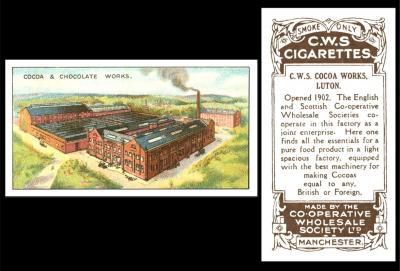
This is the Cocoa and Chocolate Works at Luton, opened in 1902. Imagine if there was no chocolate, for eating and drinking. This could happen without Fairtrade, for in many cases the Fairtrade Premium they receive on top of the price of their crop that allows them to keep going and fight off the sad facts that cocoa prices are steadily falling, that climate change is affecting the weather and bringing weather related crop diseases, and that the trees which give the cocoa are now in much need of replacing due to their advanced age.
Now for the answer to our teaser, as this set is listed as a set of 28, apart from, dare I say it, the spanner in the “works”, which appears in the 1920-40 LCCC handbook (Ha.107 - in the 1950 edition), where it suddenly becomes a set of 29, the additional card being of the "Pickle and Vinegar Works”. However this is not mentioned in our modern tobacco index handbook which says there are only 28 cards. And a quick search through the online auctions also finds sets of only 28 cards.
However my detective work tracked one down in a recent Loddon Auction (7th of Dec 2021) where there was a lot that actually said “Cigarette cards, C.W.S. Co-operative Buildings & Works, 5 cards, Printing Works Longsight Manchester, Leman St London, Weaving Shed Bury, Pickle & Vinegar Works Middleton Junction, & Tea Department London (gd)” and I have had a look at that card (as can you, at the Saleroom. This clearly shows the reverse says “C.W.S. Jam, Pickle, & Vinegar Works, Middleton Junction” – however the front of the card only says “Jam & Marmalade Works”. You can see this much better at the online collection of the New York Public Library
Tuesday, 22nd February 2022
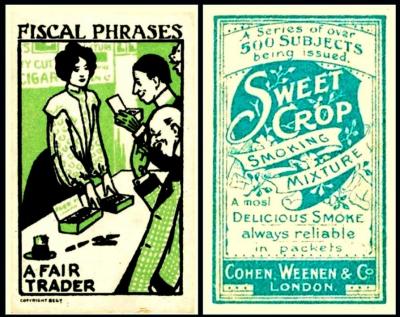
This card, "A Fair Trader", chooses to illustrate the term with a beautiful girl, fair of face.
Most people think that it was the First World War that allowed women to work in such male-dominated fields as banking, but that is incorrect - in England, we have discovered Sarah Child, who became the senior partner at her husband`s bank, Child & Co in 1782. As for in America, it looked like the first woman bank president was Maggie Lena Walker, born in 1864 in Richmond Virgina, and she started the bank herself too, in 1903. Then we found Deborah Powers, who was born in 1790 in New Hampshire, and she also started her bank, from scratch, in 1877.
Of course today "A Fair Trader" is one who is ethical and understanding, and who sells products which ensure a fair wage and good living conditions to its producers and their staff. Their goods may be slightly more expensive, but knowing how that extra is used ought to make us warm inside, and not begrudging.
This set was one of the "Sweet Crop" issues, that eventually replaced the earliest issues which had begun in 1897 - though between 1899 and 1902 they ran concurrently.
"Fiscal" is often used as another word for financial, but it technically describes moneys under the control of the Government, mostly taxes and currency. It does not sound very English and it is not, it comes from Latin, "fiscus" which means a basket. If you are confused, bear with me, for it came to mean the Roman Treasury, where the money in hand was stored in large woven baskets after it had been collected and before it was entered into the account ledgers and stored in the lockrooms.
This set is described in our original World Tobacco Issues Index as :
FISCAL PHRASES. Sm. 62 x 38. Black and green. Front (a) with (b) without "Copyright Regt". "Over 500" back. Unnd. (40). See H.93 ... C102-15
In our updated version, there is the same text, save a new, longer code, and one alteration - for the original text should have read "Copyright Regd." for registered, not "Regt." for Regiment.
These backs have not aged well, they are light to start with and the cards all seem to have browned with age, or the ink has sunk into the card making it quite light. Perhaps the board used was the problem. Anyway, eventually, I have something that will act as an illustration. And that is all we need.
Wednesday, 23rd February 2022
![B843-100 : B148-2 : USA 281 [tobacco : OS : USA] D. Buchner & Co. "American Scenes With A policeman" (untitled set) large size 95 x 57 (1888) Un/61?](/sites/default/files/styles/content_aligned/public/2022-02/23%20buchner.jpg?itok=jDdC5qkc)
The American Card Catalog of 1967 states 60 cards of this set were known, and they were valued at 50 cents each.
The titles of cards 1-42 are listed in the American Book of Checklists, and this seems to point to forty -two cards being the known set at that time. The titles of cards 43-58 then appear in our original World Tobacco Issues Index Handbook under X2/281.
I am now intrigued at the two which turned up between those, some time about the 1950s/60s which were added to the American Card Catalog - and the other one, which has given us the 61 that appears in our latest World Tobacco Issues Index, issued in the year 2000. Will have to do some fossicking!
And many thanks to Mr. Church who scanned us this lovely card from his collection.
Thursday, 24th February 2022
![[tobacco : UK] Cope "Toy Models" The Country Fair (1925) Un/25](/sites/default/files/styles/content_aligned/public/2022-02/24%20cope.jpg?itok=BUEtZa9S)
This set has a secret, which you will see if you look really closely, for it is designed as a cut out and fold model to be made, and played with, each of the twenty five cards being something or someone you would see at a country fair, so our card is “The Fruit Stall” but there are also cards of fairground attractions like “The Cokernut Shy”, “Houp La” and “Punch and Judy” as well as a “Gipsy Fortune Teller”, “The Hurdy Gurdy” and “The Caravan”.
It is a set of 25, large cards, issued with “Cope`s Kenilworth 25 Cigarettes”, and they are unnumbered, a fact which has led to some confusion for many years, as if you only find one card you get the feeling that it is number 25.
Friday, 25th February 2022
![P644-614 : P72-187 [tobacco : UK] John Player “Bonzo Dogs” overseas issue (1923) Un/25](/sites/default/files/styles/content_aligned/public/2022-02/studdy%20poair.jpg?itok=pQceem1n)
this set was issued in several versions, ours being the earliest by a UK manufacturer, even though the cards never appeared in packets in this country, it was only ever an overseas issue. That is why it has no “P/” number, for it never appeared in the original John Player reference booklet.
In the same year, 1923, British American Tobacco issued two sets, one is titled “The Bonzo Series” whilst the other series has plain backs. 1924 saw it as a trade set from Spratt's Dog Food, called “The Bonzo Series”, whilst in 1925 it was issued in South Africa by United Tobacco as “Studdy Dogs”. We had to wait until 1928 for the first UK issue, by Singleton & Cole Ltd of Shrewsbury as “Bonzo Series”.
That is where most reference books end, but the excellent and entertaining Studdying With Bonzo has also discovered another set, by Jahamdesrivaux & Albert of Martinique. Actually by translating the back, which is displayed at this site, you find out that these were two separate issuers, not one as I had supposed, and that their only connection seems to be that they both had premises in the same street, Messrs A. Jahamdesrivaux at number 21 and Victor Albert at number 6. By the way these are listed it seems like Mr. Jahamdesrivaux had started the scheme up because he is first listed although he is further down the street. Though I suppose that all depends from which way you start walking. This set is very scarce, and the reason is on the back, for it was part of a prize scheme in which if the smoker sent 500 of the coupons to either of those traders, they would receive in exchange a box of 500 “Three Roses” cigarettes.
And if you go to the main page of that Studdying site, you can read more about the lovely Bonzo and his creator, artist George Studdy, as well as see all the other ephemera and memorabilia he appeared on.
And now I have set your tails wagging, I must close. Next time we will be in March, and the weather ought to be starting to get warmer. I am delighted to see so many of our own events taking place, and also am starting to see lots of non-society ephemera and postcard fairs are springing up. If we hear of anything we think you might like then we will add it in our listings, so don’t forget to check. The very next Society events will be shown on the front page revolving banner, and just clicking the button within that box will take you to the proper page which has all events listed complete with fuller details. If we have space we will get the non-society fairs out the day before on the newsfeed section of the main page, but they will also be listed well in advance within the main page. If you know any other events we might like, do tell us please, along with any news of the clubs listed at the top who do not seem to be operational at the moment. And if any of our members are stalling out anywhere do tell us where so we can give you a little free mention.
And that is really all I have time to say today
